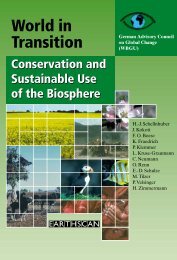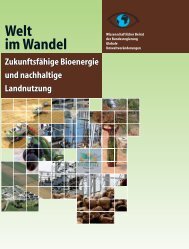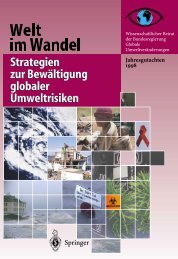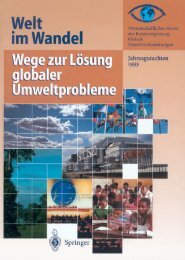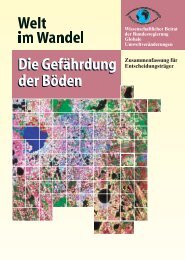World in Transition: Climate Change as a Security Risk - WBGU
World in Transition: Climate Change as a Security Risk - WBGU
World in Transition: Climate Change as a Security Risk - WBGU
You also want an ePaper? Increase the reach of your titles
YUMPU automatically turns print PDFs into web optimized ePapers that Google loves.
154<br />
7 Hotspots of climate change<br />
rapid glacier melt that this causes and <strong>in</strong>cre<strong>as</strong><strong>in</strong>g precipitation<br />
variability. Above all, serious impacts on<br />
the population’s water supply and on agriculture are<br />
to be expected. The societies concerned already face<br />
major political and socio-economic challenges and<br />
are characterized by political disputes and conflicts<br />
over the allocation of scarce resources. The (partial)<br />
destruction of the ra<strong>in</strong>forest and water scarcity –<br />
amplified by largely non-susta<strong>in</strong>able water usage and<br />
population growth – have so far resulted ma<strong>in</strong>ly <strong>in</strong><br />
conflicts that are limited to local and regional are<strong>as</strong>.<br />
Even though it is likely that there will be a gradual<br />
shift <strong>in</strong> awareness among the population and some<br />
sections of the political elite <strong>as</strong> a result of the <strong>in</strong>cre<strong>as</strong><strong>in</strong>g<br />
pressure of problems <strong>in</strong> the region, countries<br />
other than Chile are comparatively poorly equipped<br />
to meet the additional challenges aris<strong>in</strong>g from climate<br />
change effectively. As a result of political <strong>in</strong>stability<br />
and economic pressure, political plann<strong>in</strong>g is<br />
extremely short-sighted; there are serious defects<br />
<strong>in</strong> the adm<strong>in</strong>istrative structure of the state, deficiencies<br />
<strong>in</strong> the rule of law and a low level of cooperation<br />
between countries. Hence, <strong>in</strong> the near term, iterative<br />
learn<strong>in</strong>g processes are possible, but the development<br />
of a long-term adaptation strategy is unlikely. It must<br />
therefore be <strong>as</strong>sumed that climate change and the<br />
environmental changes that it causes will <strong>in</strong> future<br />
exacerbate exist<strong>in</strong>g political tensions and conflicts <strong>in</strong><br />
the Andes region.<br />
7.10<br />
Amazon region<br />
7.10.1<br />
Impacts of climate change on the biosphere and<br />
human society<br />
The Amazon ra<strong>in</strong>forest is the largest contiguous<br />
expanse of tropical forest <strong>in</strong> the world, harbour<strong>in</strong>g<br />
a significant proportion of all terrestrial plant<br />
and animal species (IPCC, 2007b). The Amazon<br />
b<strong>as</strong><strong>in</strong> extends over eight Lat<strong>in</strong> American countries;<br />
around 60 per cent of the b<strong>as</strong><strong>in</strong> lies <strong>in</strong> Brazil, while<br />
the rema<strong>in</strong><strong>in</strong>g 40 per cent is divided among Bolivia,<br />
Peru, Colombia, Venezuela, Ecuador, Sur<strong>in</strong>ame and<br />
Guyana. Around 50 per cent of precipitation <strong>in</strong> the<br />
Amazon region is generated by evapotranspiration<br />
<strong>in</strong> the region (Schubart, 1983; Salati, 1987). The most<br />
major problem <strong>in</strong> the Amazon region is cont<strong>in</strong>u<strong>in</strong>g<br />
deforestation. If present trends cont<strong>in</strong>ue, 30 per cent<br />
of the Amazonian forest could have disappeared by<br />
2050. The result<strong>in</strong>g regional climatic changes could<br />
lead to ‘savannization’, particularly of the e<strong>as</strong>tern<br />
Amazon area; this will be significantly amplified by<br />
global climate change. The transformation of tropical<br />
ra<strong>in</strong>forest <strong>in</strong>to dry gr<strong>as</strong>sland savannah would lead<br />
to the ext<strong>in</strong>ction of a significant number of species<br />
(IPCC, 2007b).<br />
For the Amazon<strong>as</strong> region of northern Brazil,<br />
regional climate projections b<strong>as</strong>ed on the A1B scenario<br />
predict a rise <strong>in</strong> temperature by 2100 of 2.6–<br />
3.7 °C aga<strong>in</strong>st a 1990 b<strong>as</strong>el<strong>in</strong>e; such a level of warm<strong>in</strong>g<br />
is 30 per cent above the global mean (IPCC, 2007a).<br />
These model projections are robust and accord well<br />
with the warm<strong>in</strong>g already recorded <strong>in</strong> the 20th century.<br />
The se<strong>as</strong>onal change <strong>in</strong> temperature distribution<br />
shows a trend towards more marked warm<strong>in</strong>g <strong>in</strong> the<br />
months of June to August compared to the months<br />
of December to February, thus reduc<strong>in</strong>g the annual<br />
temperature range (IPCC, 2007a).<br />
<strong>Change</strong>s <strong>in</strong> the regional distribution of precipitation<br />
are always hard to predict, and <strong>in</strong> the Amazon<br />
region the difficulty is <strong>in</strong>cre<strong>as</strong>ed by the very important<br />
<strong>in</strong>teractions between vegetation and climate, and<br />
by the effect of the high but narrow mounta<strong>in</strong> range<br />
of the Andes. Both factors are poorly depicted <strong>in</strong> current<br />
models. A further factor contribut<strong>in</strong>g to the level<br />
of uncerta<strong>in</strong>ty is the future trend of the El Niño phenomenon,<br />
which leads to significant droughts <strong>in</strong> the<br />
Amazon region. At present, therefore, it is impossible<br />
to make any statement about future changes <strong>in</strong> mean<br />
precipitation (IPCC, 2007a). However, droughts will<br />
occur <strong>in</strong> future <strong>as</strong> a result of the significant warm<strong>in</strong>g<br />
of the Atlantic and the <strong>as</strong>sociated changes <strong>in</strong> atmospheric<br />
circulation, irrespective of the El Niño phenomenon<br />
(Cox et al., 2004; She<strong>in</strong> et al., 2006).<br />
In the Amazon region, the year 2005 w<strong>as</strong> notable<br />
for its extraord<strong>in</strong>ary dryness. This unusual event<br />
could be a herald of the drought years that, accord<strong>in</strong>g<br />
to climate projections, will occur ever more frequently<br />
<strong>in</strong> the region. Accord<strong>in</strong>g to model calculations<br />
of the Hadley Centre (HadCM3), from 2050<br />
onwards the Amazon region will be able to absorb<br />
less and less carbon from the atmosphere. Higher<br />
air temperatures comb<strong>in</strong>ed with <strong>in</strong>cre<strong>as</strong><strong>in</strong>g dryness<br />
will reduce carbon fix<strong>in</strong>g by the ra<strong>in</strong>forest; the effect<br />
will be amplified by a further decre<strong>as</strong>e <strong>in</strong> the area of<br />
the ra<strong>in</strong>forest. In the models of Cox et al. (2000), this<br />
reduction of carbon storage <strong>in</strong> the Amazon region<br />
results <strong>in</strong> the terrestrial biosphere becom<strong>in</strong>g a global<br />
source of carbon <strong>in</strong> future. More recent predictions<br />
<strong>as</strong>sume that, <strong>in</strong> the extreme c<strong>as</strong>e, 65 per cent<br />
of the Amazon forest area will disappear by 2090 <strong>as</strong><br />
a result of <strong>in</strong>cre<strong>as</strong><strong>in</strong>g <strong>in</strong>cidence of droughts (Cox et<br />
al., 2004; Hutyra et al., 2005). The transformation of<br />
the Amazon b<strong>as</strong><strong>in</strong> <strong>in</strong>to a savannah landscape (IPCC,<br />
2007a) would rele<strong>as</strong>e additional carbon dioxide <strong>in</strong>to<br />
the atmosphere, which would <strong>in</strong> turn accelerate climate<br />
change (Section 5.3.4).





